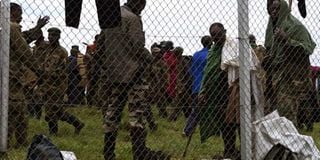M18 rebels test the waters where M23 have drowned

Some M23 rebels who surrendered to the Ugandan army stand in an isolated compound in the village of Rugwerero in Kisoro District, about 500 Kms west of Kampala, last week. More than 1,500 M23 rebels have surrendered after the Congolese army took over one of the rebel strongholds of Bunagana. Photo by AFP
Kampala- On Monday, the planned signing of a peace pact between the M23 rebels and the DR Congo government flopped.
Kinshasa said it could only sign a document committing the rebels to formally declare fighting against President Joseph Kabila’s government.
The M23 rebels, Congolese official contend, were obliterated in the battlefield with assistance of UN-backed regional intervention brigade and cannot posture as if they were equals and demand peace agreement.
Some observers prefer DRC shows fairness in shared victory, address practical governance challenges in east of the country while the Sultani Makenga fighters should accept the defeat with humility.
Neither party seems willing to relent. And anxiety holds over the possibility of resumption of fighting between the two sides.
Like a beautiful bride attracting all diverse of suitors, the loosely governed mineral-rich eastern DRC is home to several rebel and militia groups that the defeat of one is substituted with emergence of another, either weaker or stronger one.
And one such nascent group is M18, also known as the Congolese People’s Liberation Army, whose incursions in late October sent thousands of Congolese refugees into West Nile’s Koboko district, merging with the flight in south-western Uganda of M23 rebels.
So who are the M18 and what are they fighting for?
There is varying account about their identity and motivation. According to intelligence sources, the present leaders of the new rebel group were in a break-away faction from then General Jerôme Kakwavu-led People’s Armed Forces of the Congo (UDC/FAPC).
Kakwavu, a former traffic officer who rose to become a four-star warlord, carved himself an endowed enclave at the Uganda-DRC-South Sudan border, and headquartered in Aru town in Ituri province, eastern DRC.
“He acquired a private army and a lucrative kingdom in one of the remotest parts of Africa, where Congo meets Uganda and [South] Sudan,” BBC journalist Tim Whewell recounted of the warlord’s exploits in a November 16, 2003 article following a treacherous trip to FAPC’s lair.
“(Kakwavu) controlled a large open-cast gold mine, forests of valuable timber and customs posts which according to UN investigators net him thousands of dollars a week.”
Because he was of Bantu extraction, the dominant Nilotic fighters under his command during their active days in early 2000 felt side-lined and exploited, and broke ranks.
These included the Alur, Kakwa, Lugbara, Zande and Lendu. They had neither organisational nor training competence, and often operated like criminal gangs, thirsty for loot and blood.
Ben Benjamin Muki, an exiled former Uganda army soldier under Idi Amin, reportedly commands the re-organised M18 rebel force.
He apparently was an undercover Kampala agent on LRA rebels when they infiltrated parts of eastern DRC close to the Ugandan frontier.
Some names such as Ape, Katanga, Eneku and Tongo, believed to be receiving treatment in a neighbouring country after sustaining gun-shot wounds, are among the group’s prominent leaders.
Behind group
In Kampala, a UPDF Colonel arrested in West Nile on March 22, is on trial over alleged kidnap of renegade Congolese officer, Lt Col Ndamira Zackaria alias Eric Ndozi, said to be a brain behind the rebel group.
Col Fenekansi Mugyenyi, formerly the 4th Division commander, has been charged with trespass and conduct prejudicial to good order and discipline of the UPDF.
His case highlights the intricate nexus between the little known M18 and neigbouring militaries or powerful elements within the national armies. Meanwhile, the indiscipline of M18 troops already stirred uneasiness among sympathisers amid unconfirmed reports some of the groups meeting have been held, and recruitments target, Arua and Koboko districts in West Nile as well as in South Sudan.
A spate of armed attacks on Juba-bound Ugandan traders inside remote parts of South Sudan on the Kaya-Juba route have been blamed on M18 elements, with raids frequently occurring during the day.
When they failed to enlist support from their Kakwa kinsmen in DRC, they expelled them beginning October 19, piling humanitarian crises on West Nile just the way the M23 war strained Kisoro in south-western Uganda.
It is unclear just how much M18 rebels can punch above their weight, or whether they can survive more months.
How M18 re-grouped
M18 rebels reportedly first renewed themselves as a civil disobedience pressure group, before their December 28, 2012 bloody onslaught peeled off the layers of chicanery. During that raid on Bazi custom post, which was couched as a protest against unwarranted behaviour of Congolese soldiers, M18 fighters abducted two policemen and seized some guns.
They premise their fight with Kinshasa on economic grievances and marginalisation, the same grounds almost a dozen such other armed groups give to justify insurrections in eastern DRC.
According to security sources familiar with the new group, they say they are unhappy about lack of services and inhibitive taxation, among other grievances.
“The M18 is a loose-fitting rebel outfit,” one source said. The group, another source told this newspaper, linked up with now scattered M23 rebels and agreed “loosely” to cooperate on the understanding that “they would fight from the north and M23 from the south (in eastern DRC) and meet midway to carve out the Oriental Province as a separate new country”.
With M23 dispersed, M18 look vulnerable. Worse, the UN-supported regional intervention brigade in which Tanzania, Angola and South Africa are playing lead role have put all armed groups in eastern DRC that their days are numbered.
Additional reporting by Felix Warom Okello




